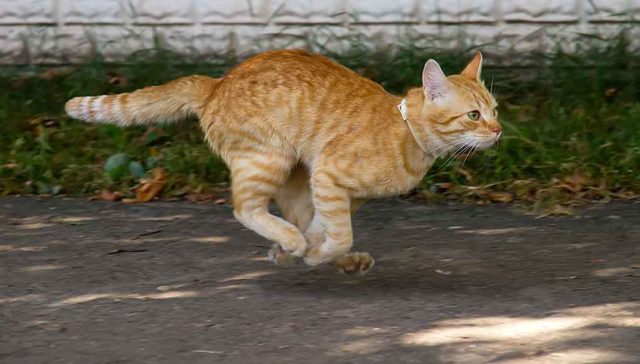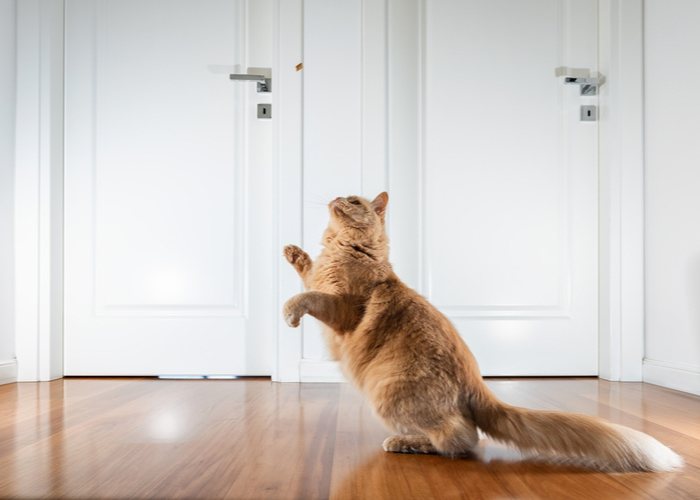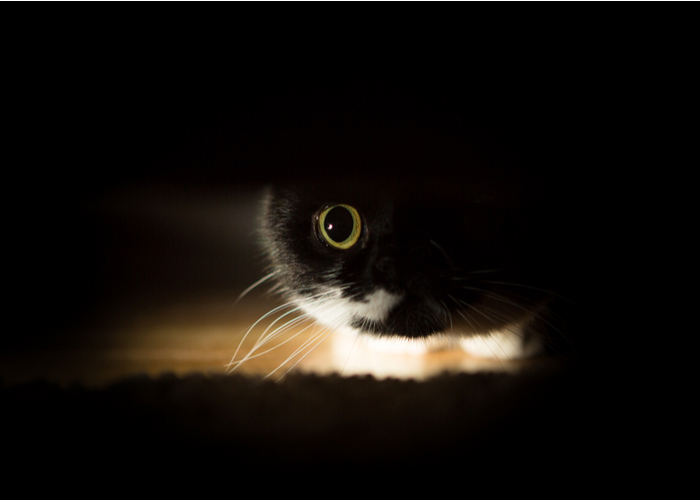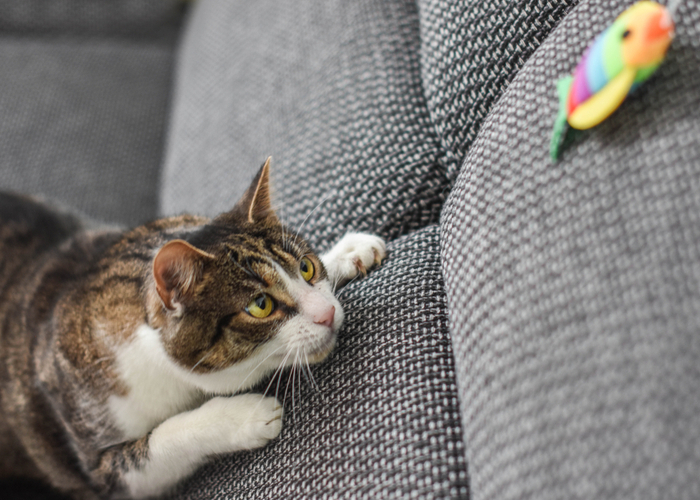
Table of Contents
Anyone who has owned a cat is probably familiar with the endearing term “zoomies.” It seems like one second, your pet is sitting around comfortably, napping on the couch, or simply just relaxing in your lap, followed by complete insanity as they run frantically around the house.
It's like your pet is suddenly possessed, chasing something completely invisible like it's not even there.
Although the endearing term zoomies is typical behavior for cats and dogs, it isn't always ideal for pet owners.
When your cat decides to go a little bit crazy at night, it can prove exceptionally frustrating. If you'd like to know more about zoomies and what causes this seemingly erratic behavior, keep reading.

Cat Zoomies: What Is It?
As the name would imply, cat zoomies are when an animal ‘zooms' around the house, frantically running like crazy.
As fast as the behavior starts, the zoomies end, and your cat is back to its standard lazy self, simply sleeping on the couch.
Most experts agree that the behavior seems like a switch has been flipped, starting and stopping as quickly as a light switch activates the light in the home.
Zoomies may act like the pet has gone crazy for no apparent reason from a cat owner's perspective.
Experts recognize this isn't the case, with Frenetic Random Activity Periods or FRAPs as the root cause. When a feline gets a sudden, intense burst of energy, running rapidly around the house is the easiest way to get that energy out.
Understanding Why Cats Get Zoomies
There are several reasons for this behavior, although each cat is different. Here are the three most common reasons for excessive energy bursts.
Excess Energy
The most common reason cats experience the zoomie's behavior is pent-up energy. Most cats will rest and sleep for most of the day, namely to conserve energy for short and highly active periods.
Without intentional exercise and activity, your feline companion will need to find a way to exert the extra energy, which most often results in the case of zoomies.
All cats are ambush predators, enabling them to conserve energy for multiple short bursts when hunting.
Indoor cats that don't get enough exercise will often engage in zoomies to release some of the pent-up energy releases.
As cats of all ages often experience this phenomenon from different energy stores, the behavior is most common in younger cats or kittens with extra energy to expend throughout the day.
Offering plenty of engaging exercise throughout the day can offset the issue, allowing your fur baby to release the extra energy without ruining your favorite carpet or knocking down vases.
You'll also spend quality time through play and enrichment activities, bringing a healthier and happier life.
Acute Pain Can Cause Cat Zoomies
Although this is a far less common reason for zoomies with your pet, it's a critical behavior to recognize. If your cat suddenly acts out, it may indicate that your kitty is in pain, making a trip to the vet essential for fast relief of symptoms.
An aging cat may be struggling with eyesight or hearing and become easily spooked by everyday items within the home.
Should your cat struggle with itchy skin or fleas, racing around the house is a way to escape the feeling. The startle zoomie reaction is one way to show fear or anxiety within the home.
If you're deciding whether your cat is in pain or whether they've got extra energy to burn, assessment is the first step.
Spend a few moments looking for other behaviors that indicate injury or illness. These symptoms include excessive licking, scratching, irritability, and pain.
For instance, a cat that engages in repetitive licking in a particular area on top of zooming around may suggest anxiety or discomfort.
Even if your cat isn't exhibiting common signs of pain, zoomies frequently occurring after regular exercise might warrant a vet appointment.
Post-Poop Cat Zoomies
After a satisfying trip to the litter box, some cats enjoy a victory lap. If your cat gets a case of zoomies after going to the bathroom, pay attention to the common signs of constipation.
These symptoms include vomiting, defecation outside the litter box, discomfort, or changes in the stool.
If your cat suddenly starts exhibiting these behaviors, it's always good to check in with the veterinarian.
Once you've ruled out digestive issues, make sure your cat's litter box is regularly cleaned.
Occasionally, cats will get a case of the zoomies after pooping in the box. After visiting the box, the rapid burst of energy is commonly connected with the vile and unpleasant smell. Having a clean litter box holds other benefits too.
You'll lessen the likelihood of bacterial infections and urinary problems in your pet and help the cat stay within the box's confines instead of on a favorite rug.

Cat Zoomies at Night?s How to Prevent Them
Cat parents everywhere are likely to understand the struggle with late-night bursts of energy.
Cats spend between 15 and 20 hours sleeping or resting a day, but it seems like the only time they're awake and ready to go is when the house is quiet.
A cat that consistently engages in zoomies is likely telling their owner they need more exercise throughout the day.
If your cat is infamous for waking you up with an early morning run through the house, finding a solution is imperative.
Make sure your pet is getting plenty of exercise throughout the day, breaking up activities.
Aim for at least two 15-minute interactive play sessions per day, or more if required. Look for toys that engage your pet in a physically and mentally stimulating way.
Feathers, bells, catnip, and other interactive toys are lovely ways to integrate physical activity with play.
It's also essential to offer mental exercise with regular playtime activities. Just as physically exhausting the pet, you need to blend mental activity with any move to encourage the cat's mind.
Play in a way that allows your cat to plan and stalk the toy, allowing integration of all senses. Playtime must hold just as much mental exercise as it does physical components.
Try a few different interactive toys that allow your cat to play and get rewarded simultaneously to tire your kitty mentally.
Make sure you leave a few other toys or activities for your fur baby to play with throughout the evening, as it will get the extra energy out.
If your cat has spent all their energy during the day, they're more likely to be tuckered out in the evening.

Games to Play with Your Cat to Tire Them Out
Ensuring your cat lives a happy and healthy life starts with mental stimulation. To help get you started, here are a few interactive games you can play with your cat to satisfy their psychological and physical needs.
Fetch
While many people play fetch with their dogs, many are surprised to learn that cats also love to play fetch or chase after an object.
The pursuit stimulates the portion of their brain that catches prey in the wild. To play, get the attention of your fur baby by calling their name.
Show them the toy or ball they enjoy playing with and toss the chosen object around. Your cat should leap and play with the toy, trying to retrieve it.
Call your pet back and offer a treat to reward the behavior. Eventually, your cat may learn to return the toy after some practice.
Food Play
Puzzle feeders are a simple method of engaging in hunting and working for their food.
As food is naturally motivating, the puzzle can bring a rewarding aspect to your pet's daily routine.
Fill a simple puzzle with food in a way that doesn't require much effort for the reward. You can find food dispenser balls or do your food puzzle; the idea is to hide food inside the toy.
You don't want your cat to get frustrated by the toy and give up.
Catnip
Catnip often helps cats relax positively, reducing anxiety levels and providing a sedative effect. For cats needing more exercise, add extra catnip to toys to make play more enticing.
Most cats will react to catnip by flipping, rolling, and rubbing at the items, but make sure that it's used sparingly.
Chasing Prey Instinct
If you're trying to tire out your cat, there's nothing better than the prey drive. Look for fun and interactive games to play with your furry companions, building a bond with your pet while improving their health.
Incorporate games that involve jumping, bouncing, and running while attempting to catch a toy.
Hide and Seek
A classic game of hide-and-seek is a valuable and practical way to bond with your kitty.
You can hide behind any objects within your home, encouraging your pet to find you. Choose more accessible locations, like behind a desk, couch, or bed. The goal is to have your cat playfully try to stalk you, making you their prey in this game.
Some cats will also enjoy hiding and try to tuck themselves away somewhere while you look for them. It's the perfect hybrid of mental stimulation and overall excitement.
Playing on a Tablet
While many people use their tablets as a method of entertainment, there are plenty of free games that work well for your cat.
Look for an entertaining game of catching digital prey, whether moving fish, mice, or other luring graphics. Watch your pet try to capture the digital characters as they jet across the screen.
Teach Them a Cat Trick
Training your feline is a fabulous way to connect your cat with the mental stimulation they need to relax.
While training your cat isn't always straightforward, it can come with a few benefits over time. Start with a simple ‘sit' command, building the basic understanding before moving on to more advanced tricks with time.
With a treat in one hand, let your cat smell the food. Slowly push the treat back into your cat, aiming for between the ears, just above their head. When they sit down, praise them and offer the treat.
Repeat this process until your cat gets the hang of it, remembering to reward them every time they complete the task.
Climbing Structures
Most cats enjoy climbing multi-tiered structures, gaining height and security. Ensure that all climbing structures offer hiding spots and a high shelf to get a better vantage point of the world.
Periodically hide treats throughout the vertical structure, giving them items to search for during play. For extra stimulation, use a few dangling toys to engage the pet further.
Adding a Pet Fishing Rod
As toys are suitable for active pets, having a dangling fishing rod toy can encourage pets to play.
Use these toys to get your cat running, chasing, diving, and climbing to attack. Dart the toy across the living room floor, into the air, or even behind furniture.
Always start by playing with the toy slowly to capture your pet's attention, speeding up as the cat interacts with the toy.
Make sure that any play isn't harmful to the pet, paying attention when the cat captures the toy (don't pull it or yank it on the rod).
Cat Zoomies: Final Thoughts
Although no one likes waking up to a cat running through the house at 2 am, it's more annoying than problematic health-wise.
Zoomies may appear comical to inexperienced pet owners, but they're a normal and healthy part of a cat's development. Cats with the occasional energy throughout the day (or during the early morning hours) are probably just burning off extra energy.
Still, it may periodically suggest something more severe. It's always good to talk to your vet about sudden or new cases, especially when your pet shows other symptoms.
Make sure you keep a log of any new or worsening behaviors before you take them to the vet, as proper records will help your vet determine the probable cause of the behavior.












